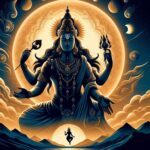The Saptarishi are Bhagawan Brahma’s seven mind-born offspring, and each plays a distinct duty during a manuantara, which lasts 306,720,000 Earth Years. Throughout this time, they function as Brahma Ji’s representatives. After each manuantara, when the universe is destroyed, the Saptarishis merge with Brahman, and new Saptarishis are chosen to revitalize the Earth and share their divine wisdom.
To keep the Earth in balance, the first group of Saptarishis worked closely with the Adi Yogi, or Shiva. The identities of the current Saptarishis during the Vyvasvata manuantara may differ amongst texts, probably due to the loss of original writings throughout time. Their identities are recorded in the Shanti Parva of the Mahabharata.
मरीचिरत्र्यङ्गिरसौ पुलस्त्यः पुलहः क्रतुः |
वसिष्ठश्च महातेजा एते चित्रशिखण्डिनः।।
“The seven revered Rishis—Marichi, Atri, Angiras, Pulastya, Pulaha, Kratu, and Vasishta—possessing immense energy, collectively referred to as Chitra-sikhandins.”
In the context of the Vaivasuara Manuantara, the Srimad Bhagavatam 8.13.5 mentions a distinct set of seven sages: Kasyapa, Atri, Vasistha, Visvamitra, Gautama, Jamadagni, and Bharadvaja.
Furthermore, in ancient Indian astronomy, the constellation of the Big Dipper is known as “Saptarishi,” with its seven stars representing the seven rishis. It is fascinating to notice that Ursa Major, Big Bear, and Saptarishi all point to the same constellation in the night sky.
Also in the Hindu Holy Literature, time has numerous dimensions and is quantified in multiple units. Kalpa is one of the largest such units. The Vishnu Purana and the Bhagvat Purana define Kalpa as 4.32 billion years of Bhu-Lok, or earth time. In Brahma-Lok, one Kalpa equals one day of Brahma. Furthermore, each Kalpa contains fourteen Manvantars. Each Manvantar, or cyclic phase, is the responsibility of Manu, the king and humanity’s torchbearer for that period. Each Manvantar is then divided into seventy-one Yuga cycles. Maha-Yuga is a cyclic age that consists of four Yugas: Satya-Yuga, Treta-Yuga, Dwapar-Yuga, and Kali-Yuga. According to religious traditions, the first Manvantar of the present Kalpa was Svayambhuva. And his Saptarishi included Atri, Angiras, Pulaha, Pulastya, Kratu, Marichi, and Vashistha. In Hindu astronomy, the stars of the Big Dipper constellation are named after these Rishis, as is the constellation itself, Saptarishi. The current Manvantar is the seventh of fourteen Manvantars in the contemporary Kalpa. The present Manu is Vaivasvat Manu, and the Saptarishi are Vashistha, Bharadwaj, Atri, Gautam, Jamadagni, Vishwamitra, and Kashyap. Vashistha and Atri were in the first and seventh Manvantars, respectively, implying their immortality and ability to live beyond them.
Now the indentities of Saptarishis varies from text to text but the names that are common are Kashyapa, Atri, Vashishta, Vishwamitra, Jamadagni, Bharadwaja and Gautam. Each of them are the powerhouse of Vedic knowledge, wisdom, astrology, medicine, rituals. Eage sage diversified special power in deep medidation of their own transferring the knowledge to humankind. They are the forming basis of the Vedas. Hinduism is also called Sanatan Dharma or The Eternal Truth. the ulmiate goal of life is freedom for the Moksha.
Rishi Bharadwaj : His knowledge has helped mankind over ages. He is known to the son of Guru Brihaspati, he composed sections of the Rig Veda, He learned the science of ayurveda and his words are found in Charak Samhita, one of foundational basis of Ayurdeva. He was the father of Dronacharya, who was the guru of the Kauravas and the Pandavas of Mahabharat. His presence is also known in Ramayan where Sr Ram, Lakhshman and Sita present some time during their exile with him.
Rishi Vishwamitra : The famous Gayatri Mantra is composed by Rishi Vishwamitra. He had rose to his supreme power of knowledge and truly attained a Brahmarishi through his own power. He was a Kshatriya King but had a battle with rishi Vasistha. He lost the battle but had a deep respect for the rishi.
Rishi Vashistha : Rishi Vasishtha is Arundathi’s husband and a Saptarishi of this Manvantara. He is Lord Brahma’s mind-born son and the Raja-guru of the Surya Vamsha, also known as the Solar Dynasty. He is the author of Vasistha Samhita, a book on electoral astrology. A hymn in the Rig Veda honors him and his family.
Rishi Gautam : Gautam Rishi belongs to the lineage of Angiras. His sons were Vamadeva, Nodhas, and Shatananda, and he was one of the earliest writers of Law. He also wrote the Gautam Dharma Sutra and the Rig and Sama Vedic mantras. His bride was Ahalya, Lord Brahma’s daughter. At the appropriate moment, the Lord proclaimed that the first person to go around the Earth would win Ahalya’s hand. Gautam Rishi went around the heavenly cow, so meeting the criterion. Ahalya and Gautam Rishi got married. Gautam authored the Gautam Dharmasutra, the first scripture on social and religious regulations. He also penned the Gautam Medhsutra. He is credited with the creation of the Godavari River. He was the son of Maharishi Rahugana and Mata Pradveshi. He was married to Ahalya. He was a devout devotee of Lord Shiva and founded the Trimbakeshwar Jyotirlinga.
Rishi Atri : Rishi Atri is known for his penitential spirit. He is regarded as the father of Dattatreya, a divinity who is a manifestation of the Holy Trinity. Anusuya, Atri’s wife, embodies purity. He is regarded as one of the leading discoverers of sacred mantras. The great sage created two works: Atri Samhita and Atri Smriti. Atri is also regarded as one of the fathers of Hindu astrology, and is credited with creating numerous Hindu books, notably the Atri Samhita, which incorporates the sage’s teachings.
Rishi Kashyap: Rishi Kashyap is also regarded as a progenitor of the human race, having created the first humanity from his own body. He is also credited with creating the earth and all living things, including animals and plants. Kashyap is also famed for his son Garuda, who is half-man and half-bird and serves as Lord Vishnu’s mount.He is Rishi Marichi’s son, and Brahma’s grandson. He was the father of Devas, Asuras, Nagas, Garudas, Vamana, Agni, Adityas, Daityas, Aryaman, Mitra, Pusan, Varuna, and the entire human race. He is the progenitor, Prajapati.
Rishi Jamadagni : Jamadagni is the father of Parashurama, Vishnu’s sixth avatar. Also a descendant of Sage Bhrigu, one of Brahma’s Prajapatis. Renuka, his wife, would gather water from the river in an unbaked clay pot using the power of her chastity. Her heart was filled with yearning one day when she saw a bunch of Gandharvas flying through the sky. The pot dissolved. She stays away from home because she is terrified of her spouse. Jamadagni, knowing this from his yogic talents, orders Parashurama to kill her mother, which he accomplishes. Jamdagni is thought to be a symbol of self-control, discipline, and spiritual strength. He is honored as a symbol of wisdom and devotion to God, and Hindus worship him for his spiritual knowledge and insight.



